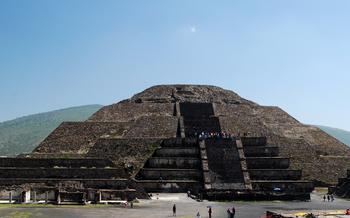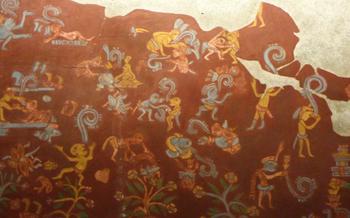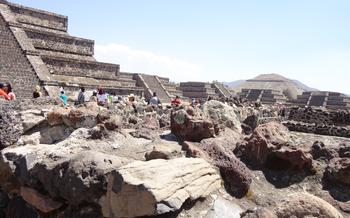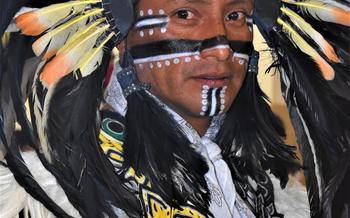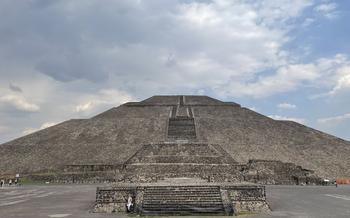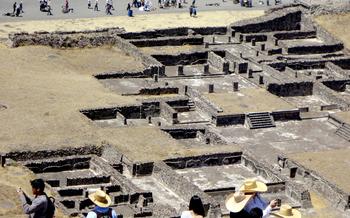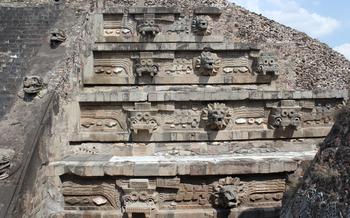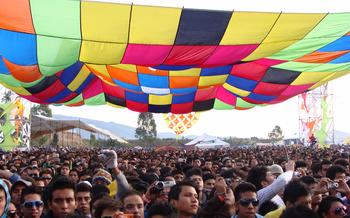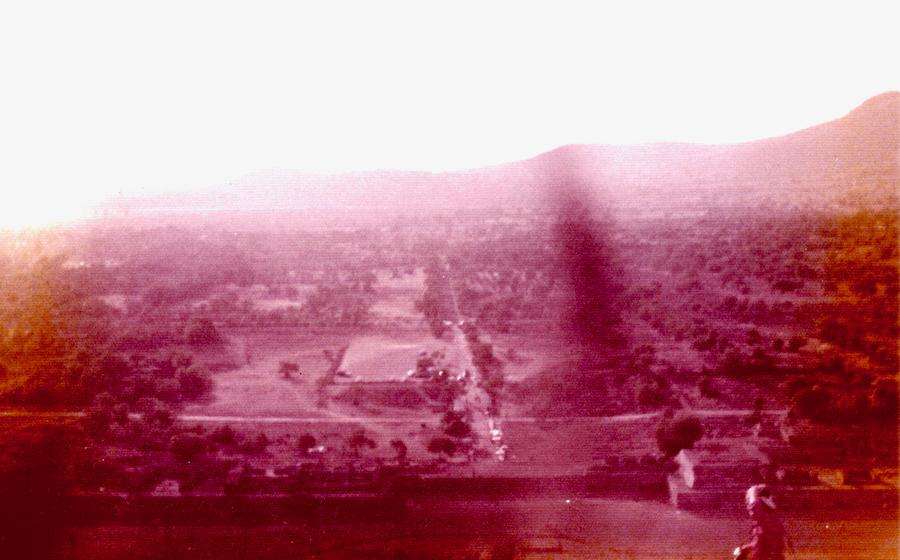
Temple of the Feathered Serpent (Quetzalcoatl) Basement
- The Temple of the Feathered Serpent (Quetzalcoatl) Basement: An Overview
- Exploring the Facade: A Masterpiece of Ancient Art
- Stepping Inside the Temple: A Journey into the Past
- Climbing the Pyramid: A Test of Strength and Will
- The Rituals and Ceremonies: A Glimpse into Aztec Spirituality
- The Architectural Wonders of Teotihuacan: A City of Pyramids
- The Avenue of the Dead: A Path to the Divine
- The UNESCO World Heritage Site: A Legacy for Humanity
- Photography at the Temple: Capturing the Grandeur
- Guided Tours: Unveiling the Secrets of the Temple
- Nearby Attractions: Exploring Teotihuacan Beyond the Temple
- Insider Tip: Discovering Hidden Gems
The Temple of the Feathered Serpent (Quetzalcoatl) Basement: An Overview
Embedded within the heart of Teotihuacan, an ancient metropolis that flourished in the Valley of Mexico, lies the Temple of the Feathered Serpent, a testament to the architectural prowess and spiritual beliefs of the Aztec civilization. This colossal structure, dedicated to the revered deity Quetzalcoatl, stands as a symbol of power, divinity, and the intricate mythology that shaped the Aztec world.
Built between the 1st and 7th centuries AD, the temple served as a sacred ceremonial center, a place where the Aztecs performed elaborate rituals and paid homage to their gods. Its significance in Aztec mythology is immense, as Quetzalcoatl, the feathered serpent deity, was believed to be the creator of humankind and the bringer of knowledge and civilization.
The temple's unique architectural features set it apart from other structures in Teotihuacan. Its facade, adorned with intricate carvings depicting serpent heads and other symbolic elements, exudes an aura of grandeur and mystery. The pyramid's steep staircase, leading to a summit that offers breathtaking views of the surrounding landscape, adds to the temple's allure and invites visitors to embark on a journey through time.
Exploring the Facade: A Masterpiece of Ancient Art
The facade of the Temple of the Feathered Serpent is a testament to the artistic prowess of the Teotihuacan people. Dominated by two colossal serpent heads, it exudes an aura of power and majesty. The serpents, with their gaping mouths and sharp fangs, are believed to represent Quetzalcoatl, the feathered serpent god.
The intricate carvings on the facade depict scenes from Aztec mythology, narrating the stories of the gods and their interactions with humans. These carvings are a testament to the skill and precision of the Teotihuacan craftsmen. The use of color, though faded over time, adds depth and vibrancy to the facade, enhancing its overall grandeur.
Standing before the temple, one cannot help but be awestruck by the sheer size and grandeur of the facade. It is a masterpiece of ancient art, a testament to the creativity and ingenuity of the Teotihuacan civilization.
Stepping Inside the Temple: A Journey into the Past
Venturing into the temple's dimly lit interior is like stepping back in time. The layout is simple yet awe-inspiring, with a central altar dominating the space. Here, ancient priests performed sacred rituals and offered sacrifices to appease the gods. The air is thick with an aura of mystery and reverence, transporting visitors to a bygone era.
The walls are adorned with vibrant murals that depict scenes from Aztec mythology and daily life. These intricate paintings offer a glimpse into the beliefs and practices of this ancient civilization. The central altar, carved with intricate designs, is a testament to the skill and artistry of the Aztec craftsmen. It served as a sacred platform for offerings and rituals, connecting the earthly realm with the divine.
The atmosphere inside the temple is palpable, filled with a sense of history and spirituality. Visitors can almost feel the presence of the ancient Aztecs, their prayers and chants echoing through the centuries. It is a truly immersive experience that allows visitors to connect with the past and gain a deeper understanding of this fascinating civilization.
Climbing the Pyramid: A Test of Strength and Will
The Temple of the Feathered Serpent is not just a place of worship; it is also a physical challenge. Visitors who wish to experience the temple from its highest point must climb the steep pyramid that serves as its base. The pyramid is composed of 360 steps, each one a testament to the strength and determination of the ancient builders.
The climb is not for the faint of heart. The steps are uneven and worn, and the angle of the pyramid is unforgiving. Climbers must use their hands and feet to pull themselves up, and the thin air at the top can make breathing difficult. But the effort is worth it. The views from the top of the pyramid are breathtaking. Visitors can see for miles in every direction, taking in the vast expanse of the Teotihuacan complex and the surrounding countryside. The sense of accomplishment upon reaching the top is unparalleled. It is a feeling of triumph that will stay with visitors long after they have descended the pyramid.
The Rituals and Ceremonies: A Glimpse into Aztec Spirituality
The Temple of the Feathered Serpent held a significant place in Aztec rituals and ceremonies. It served as a sacred space where the Aztecs expressed their devotion to Quetzalcoatl and other deities. Various ceremonies were held within the temple, each with its unique purpose and symbolism.
One of the most important rituals performed at the temple was the human sacrifice. The Aztecs believed that by offering human lives to the gods, they would ensure the continued fertility of the land and the prosperity of their empire. Sacrifices were typically carried out on the central altar of the temple, where the victim's heart would be cut out and offered to the gods.
Another common ritual was the burning of copal incense. Copal was a sacred resin that was burned to create a fragrant smoke that was believed to carry prayers and offerings to the gods. The smoke from the copal incense would rise towards the heavens, carrying with it the petitions and gratitude of the Aztec people.
In addition to these major rituals, the temple was also used for a variety of other ceremonies, such as rain-making ceremonies and healing rituals. The Aztecs believed that by performing these rituals at the temple, they could influence the natural world and bring about positive outcomes.
The rituals and ceremonies held at the Temple of the Feathered Serpent were an integral part of Aztec spirituality. They allowed the Aztecs to connect with their gods, express their devotion, and seek their favor.
The Architectural Wonders of Teotihuacan: A City of Pyramids
The ancient city of Teotihuacan, located just northeast of Mexico City, is renowned for its impressive pyramids, which are among the largest in the pre-Columbian Americas. The most famous of these pyramids are the Pyramid of the Sun and the Pyramid of the Moon, which stand at heights of 213 feet and 142 feet, respectively. These massive structures were built using a combination of mud bricks and stone, and their construction required a high level of engineering skill. The pyramids are aligned with the stars, suggesting that the Teotihuacans had a sophisticated understanding of astronomy.
In addition to the pyramids, Teotihuacan is home to a number of other impressive structures, including the Temple of Quetzalcoatl, the Avenue of the Dead, and the Citadel. The Temple of Quetzalcoatl is a large temple complex that is decorated with intricate carvings and sculptures depicting the feathered serpent god, Quetzalcoatl. The Avenue of the Dead is a wide, paved road that connects the Pyramid of the Sun and the Pyramid of the Moon, and is lined with temples, palaces, and other important buildings. The Citadel is a large, fortified complex that is located at the northern end of the city, and is thought to have been used as a military or administrative center.
The construction of Teotihuacan's pyramids and other structures required a vast amount of labor and resources. It is estimated that the city's population at its peak was around 200,000 people, and it is thought that the construction of the pyramids alone required the labor of tens of thousands of workers. The Teotihuacans were able to accomplish these feats of engineering thanks to their advanced knowledge of mathematics, astronomy, and engineering.
The architectural wonders of Teotihuacan stand as a testament to the ingenuity and skill of the Teotihuacan people. These massive structures have survived for centuries, and they continue to draw visitors from all over the world who marvel at their beauty and grandeur.
The Avenue of the Dead: A Path to the Divine
Stretching for over 2 miles, the Avenue of the Dead served as the central thoroughfare of Teotihuacan, connecting the city's major temples and palaces. Its imposing width, measuring over 140 feet, and its perfect alignment with the stars imbued it with a sense of grandeur and sacredness.
Along the Avenue, visitors can marvel at an array of impressive structures, each holding a significant place in the city's history and religious beliefs. The Temple of Quetzalcoatl, with its iconic serpent heads and intricate carvings, stands as a testament to the city's artistic prowess. The Pyramid of the Sun, the largest structure in Teotihuacan, towers over the landscape, showcasing the engineering ingenuity of its builders. The Pyramid of the Moon, with its serene presence, offers a contrasting yet equally captivating sight.
The Avenue of the Dead served as a stage for religious processions, rituals, and ceremonies that were central to Teotihuacan's spiritual life. It is believed that the Avenue was designed to create a direct path between the earthly realm and the divine, allowing the city's inhabitants to communicate with their gods and ancestors.
Walking along the Avenue of the Dead today, visitors can't help but be awestruck by the sheer scale and grandeur of Teotihuacan's urban planning. It is a testament to the ingenuity and spiritual beliefs of this ancient civilization, a place where the earthly and the divine converged, creating a city that continues to inspire and amaze.
The UNESCO World Heritage Site: A Legacy for Humanity
Teotihuacan's designation as a UNESCO World Heritage Site in 1987 is a testament to its outstanding universal value. This prestigious recognition highlights the site's exceptional cultural and historical significance, ensuring its preservation and protection for future generations. UNESCO's recognition has brought international attention and resources to Teotihuacan, enabling ongoing research, conservation efforts, and the development of sustainable tourism practices.
The World Heritage status has played a crucial role in safeguarding Teotihuacan from threats such as urban encroachment, looting, and environmental degradation. It has fostered collaboration between Mexican authorities, international organizations, and local communities to implement comprehensive management plans that balance conservation with responsible tourism development.
The benefits of World Heritage status extend beyond the preservation of Teotihuacan's physical structures. It has spurred educational programs and initiatives that promote awareness of the site's cultural heritage and its importance to Mexican and global identity. The designation has also generated economic opportunities for local communities through tourism-related activities, contributing to sustainable development in the region.
As a UNESCO World Heritage Site, Teotihuacan stands as a symbol of humanity's shared cultural legacy. Its awe-inspiring pyramids, intricate murals, and rich history continue to captivate visitors from around the world, fostering a deeper understanding and appreciation of ancient civilizations and their enduring contributions to our collective heritage.
Photography at the Temple: Capturing the Grandeur
The Temple of the Feathered Serpent is a photographer's paradise, offering countless opportunities to capture its grandeur and intricate details. For the best shots, arrive early in the morning or late afternoon when the light is soft and golden, casting long shadows that accentuate the temple's features. Experiment with different angles to showcase the temple's scale and majesty, and use a tripod to ensure sharp images. Utilize a wide-angle lens to capture the entire facade in a single frame, or zoom in on specific elements like the serpent heads or carvings for a more intimate perspective. Play with lighting and filters to create dramatic effects, and take advantage of the natural backdrop of the surrounding landscape to add depth and context to your shots. Panoramic shots can be particularly stunning, allowing you to capture the temple's full glory in a single breathtaking image. Remember to follow the site's photography regulations and avoid using flash or tripods inside the temple to preserve the integrity of the ancient artwork.
Guided Tours: Unveiling the Secrets of the Temple
Exploring the Temple of the Feathered Serpent (Quetzalcoatl) Basement with a knowledgeable guide is a truly enriching experience. Guided tours offer a plethora of benefits that enhance your understanding and appreciation of this ancient wonder.
-
In-depth Knowledge: Experienced guides provide a wealth of information about the temple's history, significance, and symbolism. They can explain the intricate carvings, murals, and architectural features, bringing the temple's story to life.
-
Personalized Attention: With a guided tour, you can ask questions and receive personalized attention from your guide. This allows you to delve deeper into specific aspects of the temple that interest you.
-
Historical Context: Guides provide historical context for the temple, explaining its role in Aztec mythology and its connection to other important sites in Teotihuacan. This helps you understand the temple's significance within the broader context of Aztec civilization.
-
Cultural Insights: Guided tours offer insights into Aztec culture and beliefs. Guides can explain the rituals and ceremonies that took place in the temple, as well as the symbolism and significance of the various offerings made to the gods.
-
Different Tour Options: Various tour options are available to suit different interests and budgets. From general overview tours to specialized thematic tours, you can choose the one that best meets your needs.
When choosing a guided tour operator, it's important to consider their reputation, experience, and qualifications. Look for operators who are licensed and have a good track record of providing informative and enjoyable tours.
Nearby Attractions: Exploring Teotihuacan Beyond the Temple
Beyond the Temple of Quetzalcoatl Basement, Teotihuacan offers a wealth of other captivating attractions. The Pyramid of the Sun, the largest structure in the city, stands as a testament to the architectural prowess of the ancient Teotihuacans. Ascending its steep steps rewards visitors with breathtaking panoramic views of the entire complex. The neighboring Pyramid of the Moon, though smaller in size, holds equal significance and offers a distinct perspective.
Strolling along the Avenue of the Dead, the main thoroughfare of Teotihuacan, is a journey through history. Flanked by impressive structures, including the Temple of Quetzalcoatl, the avenue leads to the Ciudadela, a vast plaza surrounded by enigmatic buildings.
Discover the Teotihuacan Museum, a treasure-trove of artifacts that provide insights into the city's past. Marvel at the intricate murals, sculptures, and ceramic pieces that narrate the stories of the ancient civilization.
For a glimpse into the daily lives of the Teotihuacans, explore the residential compounds scattered throughout the city. These well-preserved neighborhoods offer a glimpse into the domestic architecture and lifestyle of the city's inhabitants.
Unveil the mysteries of Teotihuacan by venturing beyond the Temple of Quetzalcoatl Basement. Each attraction unfolds a new chapter in the story of this ancient metropolis, leaving visitors in awe of its grandeur and mystique.
Insider Tip: Discovering Hidden Gems
Beyond the main attractions, Teotihuacan holds a treasure trove of hidden gems waiting to be discovered by the curious and adventurous traveler. One such secret is the tunnel beneath the Temple of Quetzalcoatl. Descend into the darkness and uncover the ancient passageways that once served as a conduit for sacred rituals.
For those seeking a breathtaking sunrise experience, venture to the easternmost point of the city, where the first rays of light bathe the pyramids in a golden glow. The spectacle of the sun rising above these ancient structures is a sight to behold.
Within the Pyramid of the Moon, a hidden chamber awaits discovery. Climb the steep steps and enter the sanctum, where you can immerse yourself in the echoes of history. Imagine the ceremonies and rituals that once took place within these sacred walls.
Finally, don't miss the vibrant local markets, where you can haggle for authentic souvenirs and handicrafts. Engage with the friendly vendors and learn about the rich cultural heritage of Teotihuacan. From intricate pottery to colorful textiles, these markets offer a glimpse into the soul of this ancient city.
